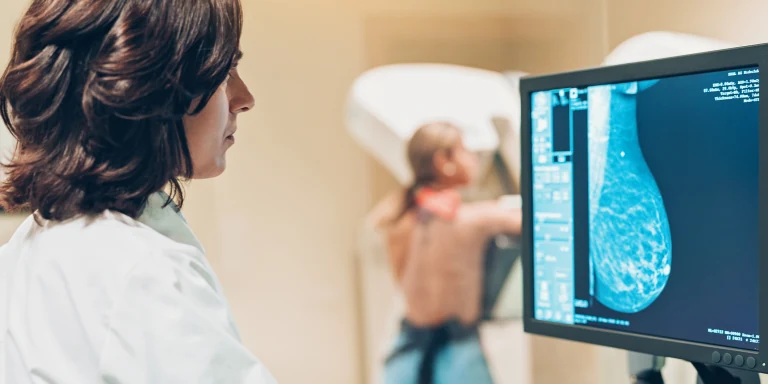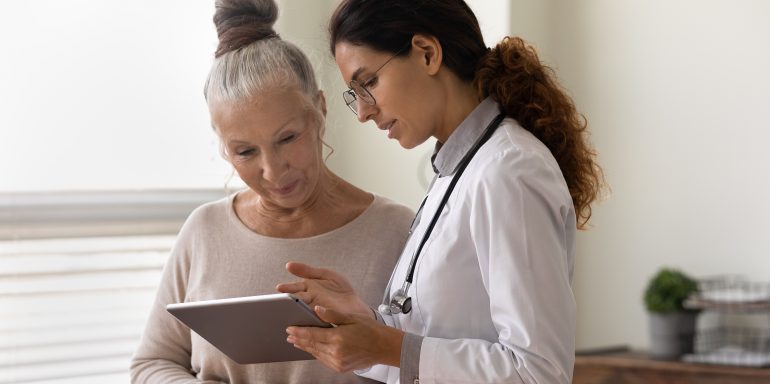
Breast cancer: early detection methods
How can you tell if you have breast cancer? What is a mammogram? Where do lumps develop in the breast, and how do they feel? How often should you check your breasts? Learn about breast cancer screening methods.
Overview of topics
Breast cancer: early detection in women
Breast cancer is the most common form of cancer in women. More than 6,000 women receive this diagnosis every year in Switzerland. The specialist medical term is “breast carcinoma”, which refers to malignant tumours that develop in the breast tissue. The risk increases with age. Around 80% of women with the disease are aged 50 or older. But the chances of survival are better than they are for some other forms of cancer, such as lung cancer or pancreatic cancer. Thanks to modern medicine and early detection, about 80% of patients are currently still alive five years after being diagnosed with breast cancer.
Early detection makes it significantly more likely that treatment will be successful. The earlier a breast carcinoma is discovered, the more targeted and therefore less harmful its treatment can be. That is why the early detection of breast cancer is crucial for successful treatment. Regular examinations enable doctors to spot suspicious changes in good time, and thus preserve breast health.
The early detection of breast cancer is regulated differently in Switzerland depending on the canton and the patient’s situation. Some cantons offer breast screening programmes for women aged 50 and over. In those cantons, women are invited to get a mammogram every two years. The costs are covered under the basic insurance provided by their health insurer. For women with an increased family risk, the health insurer will also cover the costs of additional examinations such as MRI or ultrasound scans of the breast if these are medically necessary. If a genetic predisposition is suspected, the health insurer will also cover the costs of genetic testing for breast cancer.
Find out about the services that are available in your canton, and talk to your doctor about what early detection measures make sense for you.
Breast self-examination
One simple way of spotting breast cancer early is to regularly check your breasts yourself. This gives women a sense of the natural texture of the tissue, and makes them more aware of any changes. Specialists recommend that you systematically check your breasts once a month. Carefully examine the whole breast and armpits, and feel around them with your hands. Breast cancer can sometimes be detected in its initial stages, particularly if a lump is close to the surface of the skin. The timing of when you should thoroughly check your breasts depends on your hormonal cycle:
- No hormonal contraception: Breast tissue feels softer in the days immediately following your period. This makes lumps or other changes easier to detect.
- Contraception using the pill: The best time is at the start of a new one-month pack, because hormonal fluctuations affect the breast tissue.
- After the menopause: After the menopause it is advisable to check your breasts every four weeks or so.
Not every change that you notice will be a sign of breast cancer. If you notice anything unusual, you should see a doctor immediately. They will clarify whether further investigations such as an ultrasound scan or a mammogram are required.
A malignant breast lump often feels hard, irregularly shaped and immobile. Unlike benign changes, it is less distinct from the surrounding tissue. Lumps often develop in upper outer area of the breast, near the armpit. But they can also appear in other parts of the breast tissue. Pay attention to your body, and look out for other potential symptoms of breast cancer, such as:
- Changes in the size or shape of the breast
- Changes in the skin such as redness, indentations, or a texture similar to that of an orange peel
- Changes in the nipple such as inversions, discharges or flaking
- Swelling or lumps in the armpit
Mammography: breast screening
It is not always possible to feel breast cancer, so regular self-examinations alone are not enough. Mammography supplements early detection by making minor changes in the tissue visible. X-raying the breast is currently considered the most important early detection method. This can identify even very small breast tumours that cannot be felt with the hands.
During the examination, a specialist positions the breast between two plexiglass panels. These press the tissue together to ensure even distribution and therefore better image quality. Some women find mammograms painful due to the amount of pressure placed on the breast.
Mammograms for the early detection of breast carcinomas are generally carried out from the age of 50. The examination helps detect breast cancer in its early stages, when there are no symptoms yet. X-rays are used at any age if the patient is experiencing noticeable symptoms or palpable lumps. Screening mammograms should ideally be carried out in the first half of a woman’s cycle. That’s when the breast tissue is less dense, which improves the image quality. The informative value of the examination is not affected by the size of the breast. A mammogram is just as useful for small breasts as it is for large ones.
Mammography: yes or no?
A mammogram is a simple examination that can rapidly detect changes in the breast. It reveals suspicious changes in the tissue, but offers no indication of whether potential tumours are benign or malignant.
The Harding Center for Risk Literacy at the University of Potsdam has summarised the potential advantages and disadvantages of the early detection of breast cancer using mammograms based on the available scientific studies.
Early detection of breast cancer: alternative methods
Mammograms don’t always give meaningful results. In such cases, other imaging techniques such as ultrasound and magnetic resonance imaging (MRI) of the breast can provide a more precise diagnosis. These procedures are done in addition to or replace mammography for the early detection of breast cancer.
Ultrasound breast scans
Ultrasound is used as a screening method to detect breast cancer if mammography fails to provide clear results. Ultrasound scans also make sense for certain groups of people. Here’s an overview of the different types:
- Unclear results: A mammogram is often unable to clearly recognise cysts. An ultrasound scan provides additional information, and distinguishes between fluid-filled cysts and solid lumps in the breast.
- Young women: In younger patients, dense breast tissue makes it harder to make assessments using mammography. In these cases, ultrasound provides clear images and makes it easier to detect anomalies.
- Women with breast implants: Mammograms cannot be performed on patients with implants. Ultrasound is a radiation-free way to examine the breast tissue without squashing it.
Breast MRI
Breast MRI is not a standard procedure for the early detection of breast cancer. This method is necessary in certain situations, however:
- Unclear results: MRI is often used if mammography or ultrasound fail to provide clear results.
- Increased family risk: Women with a genetic predisposition to develop breast cancer are given regular MRI examinations in order to spot changes in the breast tissue at an early stage.
- Follow-up care and suspicion of relapse: MRI is used for early detection and investigation following breast cancer treatment or if a breast tumour is thought to have recurred.
There are other methods for diagnosing breast cancer in addition to mammography, ultrasound and MRI. Some of those methods, such as thermal imaging of the breast, give imprecise and unreliable results, and are not suitable for early detection. You should ideally talk to your doctor about what kind of examination makes sense in your case.
Breast biopsy
A breast biopsy is not a routine examination for breast cancer screening. It is used when imaging techniques such as mammography or MRI provide conspicuous results. This procedure clarifies whether a change in tissue is benign or malignant. It involves the doctor taking a tissue sample and investigating it for cancer cells. In most cases, the tissue sample is taken as an outpatient procedure, using local anaesthetic.
If the biopsy confirms the suspicion of a breast carcinoma, further investigations are carried out. In this case, medical experts use immunohistochemistry to detect specific breast cancer markers. These provide information on the tumour’s biological properties. Doctors also determine whether the breast cancer has spread. A computed tomography (CT) scan of the chest and abdomen using a contrast medium helps detect metastases in other parts of the body. In certain cases, breast cancer is visible in a CT scan, particularly if the tumour has characteristic tissue structures. The results of these investigations are used to select the best available treatment.
Many women notice irregularities or changes in their breasts in the course of their lives. Palpable lumps can appear from time to time, particularly under the age of 40. These are often benign, and are no cause for alarm. Breast cancer is rare in young women.
Fibroadenomas are one of the most common forms of benign breast tumours. These lumps are made up of connective and gland tissue, feel hard and smooth, and are very mobile. They are typically painless, and grow slowly. Women between the ages of 20 and 40 are most likely to develop these lumps in their breasts. Fibroadenomas are usually harmless and do not require treatment.
Preventing breast cancer
If you have a family history of breast cancer, you can get genetic testing for the early detection of breast cancer. This will determine whether you have an increased risk of developing breast carcinomas. A positive result indicates an increased risk but does not confirm the presence of any cancer cells. Likewise, a negative result does not rule out the possibility of developing breast cancer. A history of breast cancer in the family remains a factor even if there are no detectable genetic changes. Medical experts use the test to identify specific tumour markers for breast cancer. This can then be used as a basis for taking targeted measures to prevent breast cancer.
Breast cancer cannot be prevented entirely. A healthy lifestyle reduces the risk of developing it, however. Eating a balanced diet with minimal alcohol and sufficient exercise is good for your health. Examine your breasts regularly yourself, and go to check-ups. These measures support your breast health and help you spot breast cancer at an early stage.
Cristina Nastasia is a gynaecologist and obstetrician. She is a Medical Director at the Swiss fertility clinic Cada and provided the editorial team with advice and input for this article.


Newsletter
Find out more about current health issues every month and get all the information you need about our attractive offers from all Helsana Group companies * delivered by e-mail to read whenever it suits you. Our newsletter is free of charge and you can sign up here:
We did not receive your information. Please try again later.
* The Helsana Group comprises Helsana Insurance Company Ltd, Helsana Supplementary Insurances Ltd and Helsana Accidents Ltd.